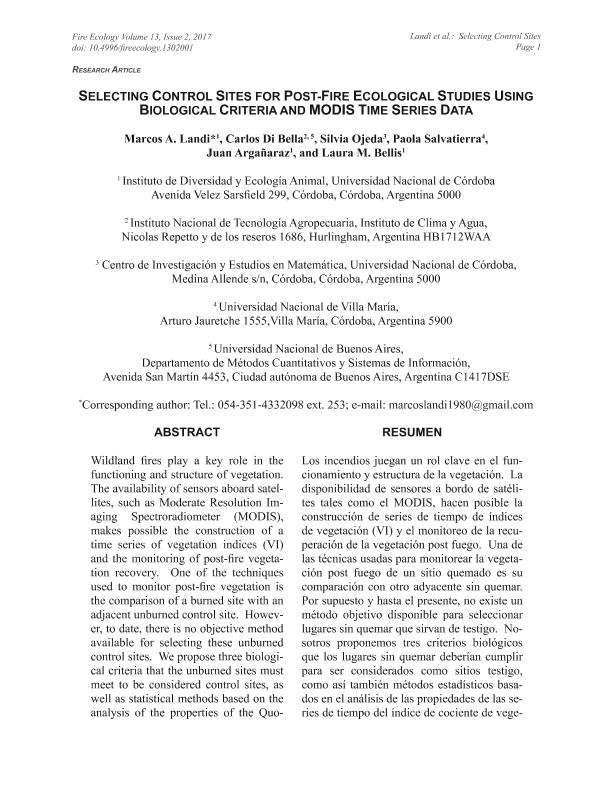Mostrar el registro sencillo del ítem
dc.contributor.author
Landi, Marcos Alejandro

dc.contributor.author
Di Bella, Carlos Marcelo

dc.contributor.author
Ojeda, Silvia

dc.contributor.author
Salvatierra, Paola Luciana

dc.contributor.author
Argañaraz, Juan Pablo

dc.contributor.author
Bellis, Laura Marisa

dc.date.available
2018-08-23T18:27:02Z
dc.date.issued
2017-02
dc.identifier.citation
Landi, Marcos Alejandro; Di Bella, Carlos Marcelo; Ojeda, Silvia; Salvatierra, Paola Luciana; Argañaraz, Juan Pablo; et al.; Selecting control sites for post-fire ecological studies using biological criteria and modis time series data; Association for Fire Ecology; Fire Ecology; 13; 2; 2-2017
dc.identifier.issn
1933-9747
dc.identifier.uri
http://hdl.handle.net/11336/56852
dc.description.abstract
Wildland fires play a key role in the functioning and structure of vegetation. The availability of sensors aboard satellites, such as Moderate Resolution Imaging Spectroradiometer (MODIS), makes possible the construction of a time series of vegetation indices (VI) and the monitoring of post-fire vegetation recovery. One of the techniques used to monitor post-fire vegetation is the comparison of a burned site with an adjacent unburned control site. However, to date, there is no objective method available for selecting these unburned control sites. We propose three biological criteria that the unburned sites must meet to be considered control sites, as well as statistical methods based on the analysis of the properties of the Quo-tient Vegetation Indices time series (QVI), to detect unburned sites that meet the proposed criteria. We also test the performance of the proposed method by checking the pre-fire difference between burned and unburned sites, assuming that the higher the number of met criteria, the greater the similarity. Therefore, we compare the differences between VI time series of burned sites and VI time series of unburned sites with the same vegetation cover that meet three, two, one, and none of the proposed criteria. In addition, we compare the quality of QVI time series that meet three, two, one, and none of the proposed criteria. Our results show that, for Normalized Difference Vegetation Index (NDVI) and Enhanced Vegetation Index (EVI) data, the difference between the time series of burned and unburned sites gradually decreases with the increase of met criteria. A gradual increase is also observed in the quality of the QVI time series with the increase of met criteria. Despite the limitations present in the proposed method, our model represents an advance from the conceptual and methodological standpoints, since this is the first proposal of a statistical method for selecting unburned control sites based on biological criteria.
dc.format
application/pdf
dc.language.iso
eng
dc.publisher
Association for Fire Ecology
dc.rights
info:eu-repo/semantics/openAccess
dc.rights.uri
https://creativecommons.org/licenses/by/2.5/ar/
dc.subject
Control Site Selection
dc.subject
Ecological Experimental Design
dc.subject
Evi Time Series Analysis
dc.subject
Fire Ecology
dc.subject
Modis
dc.subject
Ndvi Time Series Analysis
dc.subject.classification
Otras Ciencias Biológicas

dc.subject.classification
Ciencias Biológicas

dc.subject.classification
CIENCIAS NATURALES Y EXACTAS

dc.subject.classification
Matemática Pura

dc.subject.classification
Matemáticas

dc.subject.classification
CIENCIAS NATURALES Y EXACTAS

dc.title
Selecting control sites for post-fire ecological studies using biological criteria and modis time series data
dc.type
info:eu-repo/semantics/article
dc.type
info:ar-repo/semantics/artículo
dc.type
info:eu-repo/semantics/publishedVersion
dc.date.updated
2018-08-17T14:29:08Z
dc.journal.volume
13
dc.journal.number
2
dc.journal.pais
Estados Unidos

dc.description.fil
Fil: Landi, Marcos Alejandro. Consejo Nacional de Investigaciones Científicas y Técnicas. Centro Científico Tecnológico Conicet - Córdoba. Instituto de Diversidad y Ecología Animal. Universidad Nacional de Córdoba. Facultad de Ciencias Exactas Físicas y Naturales. Instituto de Diversidad y Ecología Animal; Argentina
dc.description.fil
Fil: Di Bella, Carlos Marcelo. Instituto Nacional de Tecnología Agropecuaria. Centro de Investigación de Recursos Naturales. Instituto de Clima y Agua; Argentina
dc.description.fil
Fil: Ojeda, Silvia. Consejo Nacional de Investigaciones Científicas y Técnicas. Centro Científico Tecnológico Conicet - Córdoba. Centro de Investigación y Estudios de Matemática. Universidad Nacional de Córdoba. Centro de Investigación y Estudios de Matemática; Argentina
dc.description.fil
Fil: Salvatierra, Paola Luciana. Universidad Nacional de Villa María; Argentina
dc.description.fil
Fil: Argañaraz, Juan Pablo. Consejo Nacional de Investigaciones Científicas y Técnicas. Centro Científico Tecnológico Conicet - Córdoba. Instituto de Diversidad y Ecología Animal. Universidad Nacional de Córdoba. Facultad de Ciencias Exactas Físicas y Naturales. Instituto de Diversidad y Ecología Animal; Argentina
dc.description.fil
Fil: Bellis, Laura Marisa. Consejo Nacional de Investigaciones Científicas y Técnicas. Centro Científico Tecnológico Conicet - Córdoba. Instituto de Diversidad y Ecología Animal. Universidad Nacional de Córdoba. Facultad de Ciencias Exactas Físicas y Naturales. Instituto de Diversidad y Ecología Animal; Argentina
dc.journal.title
Fire Ecology
dc.relation.alternativeid
info:eu-repo/semantics/altIdentifier/doi/http://dx.doi.org/10.4996/fireecology.130274623
dc.relation.alternativeid
info:eu-repo/semantics/altIdentifier/url/https://link.springer.com/article/10.4996/fireecology.130274623
Archivos asociados
